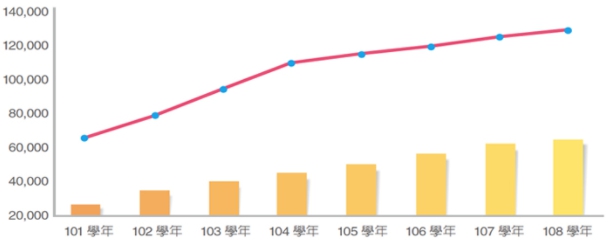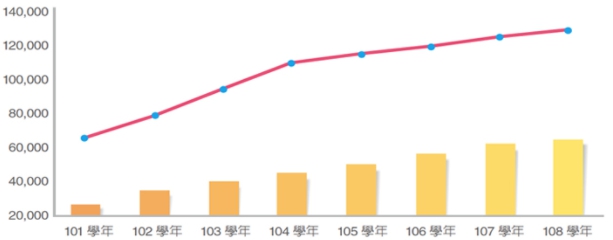International students come together to Taiwan, where the one-hundred thirty thousand overseas student mark has been passed

The number of international students who choose to study in Taiwan is growing as countries sing the praises of the quality of Taiwanese higher education with the fact that the New Southbound Policy has brought changes. Various grants integrated by the Ministry of Education, an affordable cost of living and tuition, the sound academic environment and societal structure, and, above all, Taiwan that becomes highly visible as among the few nations where school attendance remains unchanged owing to the COVID-19 pandemic under proper control have made admission to schools in Taiwan appealing to a multitude of such students.
Studying in Taiwan has become a trend for those from the New Southbound nations
The soaring number of the entire overseas students that include overseas Chinese students (also those from Hong Kong and Macau), Mainland Chinese students, exchange students, short-term trainees, and CSL/CFL students was driven along with more than ten thousand overseas students seeking a degree at colleges or universities in Taiwan in the 2011 academic year. The total number of overseas students seeking a degree was already over 63,000 in the 2019 academic year, while that of the entire oversea students reached 130,000 for the first time, and this accounts for Taiwan’s stellar record of cultivating international talents.
According to the analysis of where these overseas students were from, the number of those from the New Southbound Nations is found to have started with substantial growth in the 2016 academic year, and it continued to grow, up from 32,000, approaching 60,000 in total in the 2019 academic year with the growth rate up to 84.78 percent. This is because when drawing up the New Southbound Talent Development Program in 2017, the MOE attempted to recruit Southeast Asian students with great potential, held Taiwan higher education fairs or admission information sessions in Malaysia, Vietnam, India, Thailand, Indonesia, Myanmar, and the Philippines, and doubled the scholarship quotas for these countries.
Figure 1. The Growth Trend of the Population of Overseas Students at Colleges or Universities in Taiwan

[Orange Bar Graph] the number of overseas students seeking a degree
[Red Line Graph] the number of the entire overseas students
Source: The Ministry of Education
| Country | 2016 AY | 2017 AY | 2018 AY | 2019 AY | 2020 AY |
|---|---|---|---|---|---|
| Malaysia | 20 | 35 | 35 | 35 | 37 |
| Vietnam | 28 | 43 | 50 | 56 | 60 |
| Indonesia | 16 | 30 | 35 | 37 | 37 |
| Thailand | 11 | 15 | 15 | 17 | 18 |
| The Philippines | 2 | 5 | 10 | 14 | 18 |
| India | 12 | 30 | 36 | 41 | 41 |
| Others | 11 | 22 | 20 | 18 | 19 |
| Total | 100 | 180 | 201 | 218 | 230 |
| Country | 2015 AY | 2016 AY | 2017 AY | 2018 AY | 2019 AY |
|---|---|---|---|---|---|
| Degree Students | 19,721 | 21,882 | 25,268 | 32,360 | 36,073 |
| Non-Degree Students | 9,020 | 10,436 | 16,111 | 20,739 | 23,647 |
| Total | 28,741 | 32,318 | 41,379 | 53,099 | 59,720 |
There has been a significant increase in the number of overseas students staying in Taiwan for employment.
Transnational corporations, one after another, have placed big investments in Taiwan with its promising outlook for employment. Nearly 90 percent of overseas students agree that studying in Taiwan is like a worthwhile investment in one’s future career, as recently published in the 2020 Studying in Taiwan Online Survey conducted by the Foundation for International Cooperation in Higher Education of Taiwan. Additionally, the Ministry of Labor has gradually lifted restrictions on the employment of overseas and foreign students, which accounts for 20,819 out of 46,542 overseas and foreign students in total between 2012 and 2019 having stayed in Taiwan for employment after graduation, and the ratio increased year by year (starting from 620 in 2012 to nearly 5,000 in 2019). The retention of such great talent is expected to meet the demand of industrial transformation in Taiwan.
Figure 2. The Analysis of the Employment of Overseas and Foreign Graduates in Taiwan

[Pink Bar Graph] the number of college graduates as overseas and foreign students
[Blue Line Graph] the number of those having stayed in Taiwan for employment
Unit: Person
Source: The Ministry of Education, The Ministry of Labor, and the National Development Council


